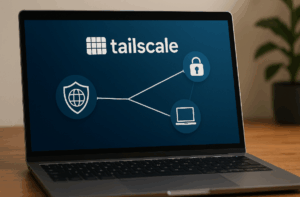<!doctype html>
Tailscale Exit Node is a simple way to run your own VPN
— without complex router setup or a public IP address. It uses WireGuard encryption and lets you browse securely from anywhere as if you were at home — or even from another country.
What you’ll need and how it works
You don’t need expensive hardware or deep networking knowledge to run a Tailscale Exit Node. You only need:
- Laptop, desktop PC, mini‑PC, or an older computer — even an older machine you no longer use day‑to‑day will do.
- Debian 13 (trixie) installed on that machine (it can run headless without a monitor).
- Internet connection — either via Ethernet port or a Wi‑Fi adapter.
- If you only want the device to provide internet egress, a single network adapter (Wi‑Fi or Ethernet) is enough.
- If you want the machine to receive internet from one network and forward it to another, you’ll need two network adapters (e.g., Ethernet + Wi‑Fi).
-
Tailscale account — free at tailscale.com (you can sign in with Google, Microsoft, GitHub, etc.).
How it works:
- The Debian machine running Tailscale becomes an Exit Node — a gateway to the internet.
- When another device (laptop, phone) connects to it through Tailscale and selects it as the Exit Node, all your traffic flows through that machine.
- On public Wi‑Fi (e.g., a hotel), you will appear to be connecting from the Exit Node’s location (e.g., your home or a VPS in another country).
- Tailscale connections are encrypted with WireGuard, so even the hotel’s network operator can’t see your traffic contents.
Goal: set up a Tailscale Exit Node on Debian 13 (trixie). When travelling, connect to any trusted Wi‑Fi and route all your traffic through your own machine — no access to the foreign router and no port forwarding needed. Data is encrypted via WireGuard; Tailscale simply helps peers find each other.
What you need
- Debian 13 (trixie) on the machine that will be the Exit Node (home PC/mini‑PC/RPi/laptop).
- A Tailscale account (sign in via Google/Microsoft/GitHub, etc.).
- Tailscale installed on your client device (laptop/phone) as well.
- No router access and no public IP required.
STEP 1 – Install Tailscale (Debian 13)
The easiest way is the official repository for trixie:
sudo mkdir -p --mode=0755 /usr/share/keyrings
curl -fsSL https://pkgs.tailscale.com/stable/debian/trixie.noarmor.gpg | sudo tee /usr/share/keyrings/tailscale-archive-keyring.gpg >/dev/null
curl -fsSL https://pkgs.tailscale.com/stable/debian/trixie.tailscale-keyring.list | sudo tee /etc/apt/sources.list.d/tailscale.list >/dev/null
sudo apt update
sudo apt install tailscaleAlternative (quick script):
curl -fsSL https://tailscale.com/install.sh | shSTEP 2 – Enable the service
sudo systemctl enable --now tailscaled
# Check status
systemctl status tailscaled --no-pagerSTEP 3 – Sign in / activate
The first run prompts you to sign in to Tailscale (it prints a URL):
# Opens a sign‑in URL. Open it in the browser and approve the device.
sudo tailscale upSTEP 4 – Enable IP forwarding (required for Exit Node)
To route client traffic to the internet, enable IPv4 (and optionally IPv6) forwarding:
echo 'net.ipv4.ip_forward=1' | sudo tee /etc/sysctl.d/99-tailscale-exit.conf
echo 'net.ipv6.conf.all.forwarding=1' | sudo tee -a /etc/sysctl.d/99-tailscale-exit.conf
sudo sysctl --systemSTEP 5 – Advertise this machine as an Exit Node
This command lets other devices use this machine for internet egress:
# Offer this machine as an Exit Node
sudo tailscale up --advertise-exit-nodeOptional: if you also want Tailscale SSH to this machine, add --ssh:
sudo tailscale up --advertise-exit-node --ssh
STEP 6 – Approve the Exit Node in Tailscale
In the Tailscale admin console, enable “Use as exit node” / “Exit node” for this device and approve it. Without approval, it won’t be offered to clients.
STEP 7 – Connect a client
7.1 Linux (CLI)
# On the client, install tailscale (per your distro) and start the service.
# Sign in:
sudo tailscale up
# Select the exit node (machine name or its Tailscale IP, e.g. 100.x.y.z)
sudo tailscale up --exit-node=<name-or-ip> --exit-node-allow-lan-access=trueAllow LAN access lets the client still see its local network (e.g., a hotel printer) while using the exit node. For a strict full‑tunnel, omit that switch.
7.2 Windows
- Install the Tailscale app and sign in.
- In the app, open Settings → Exit Node and choose your exit node.
- Optional: toggle “Allow LAN access” if you want to keep access to the local network.
7.3 Android / iOS
- Install the Tailscale app from Google Play / App Store and sign in.
- Open the Exit Node section and select your exit node.
- Optional: enable “Allow LAN access”.
Test: public IP change
- On the client, check your public IP before enabling the exit node (e.g., search “what is my IP”).
- Enable the exit node per Step 7.
- Check the public IP again — it should now be your exit node’s IP (e.g., your home connection).
# Quick test in a terminal
curl https://ifconfig.ioCommon issues
- Client won’t use the exit node: It hasn’t been approved in the admin console; on the server, run
sudo tailscale up --advertise-exit-nodeagain if needed. - No internet via exit node: Forwarding is missing (Step 4); verify
sudo sysctl net.ipv4.ip_forward(should be 1). - I want to see the client’s local LAN too: Use
--exit-node-allow-lan-access=trueor the “Allow LAN access” toggle in the app. - Diagnostics:
tailscale status,tailscale ping <name>,sudo tailscale up --reset.
Tips: LAN access, foreign VPS, Headscale
- LAN access while using exit node: Turn on “Allow LAN access”, otherwise the local network may be hidden.
- IP from another country: Run your exit node on an inexpensive VPS (e.g., in Germany) to obtain a foreign IP without touching your home router.
- Fully self‑hosted control plane: If you want to avoid any third‑party control, consider Headscale (self‑hosted alternative). For beginners, official Tailscale is simpler and very stable.
Quick checklist
- Install Tailscale (trixie repo) and enable the service.
sudo tailscale up→ sign in.- Forwarding: create
/etc/sysctl.d/99-tailscale-exit.conf→sudo sysctl --system. sudo tailscale up --advertise-exit-nodeon the server.- Approve the Exit Node in the admin console.
- Client: select the exit node (or
--exit-node=<name/IP>) and optionally--exit-node-allow-lan-access=true. - Verify public IP change (
curl https://ifconfig.io).
Easy VPN for Linux – no complicated setup
If you don’t want to create your own VPN or you’re struggling to configure everything on Linux, here’s a simple solution. Try a ready-to-use VPN for Linux with a clean graphical interface – fast, secure, and hassle-free.
View deals on Amazon →Tip: Quick installation, user-friendly GUI, no unnecessary complexity.

